Variegated String of Hearts is a unique plant with a long leafy stem and beautiful foliage and can be grown in the shade or sun. It thrives in most soil types, preferably well-drained soil. A string of hearts can be propagated by cuttings or seedlings and thrives in moist soil.
As a part of the succulent species, the string of hearts requires regular watering and weekly fertilization during the growing season. A variegated string of hearts isn’t difficult to care for, but they require more attention than other plants and need more light than most plants to stay healthy.
In this article, we’ll cover how you can grow and care for your variegated string of hearts so that they can remain alive and healthy for many years!
What is a Variegated String of Hearts?
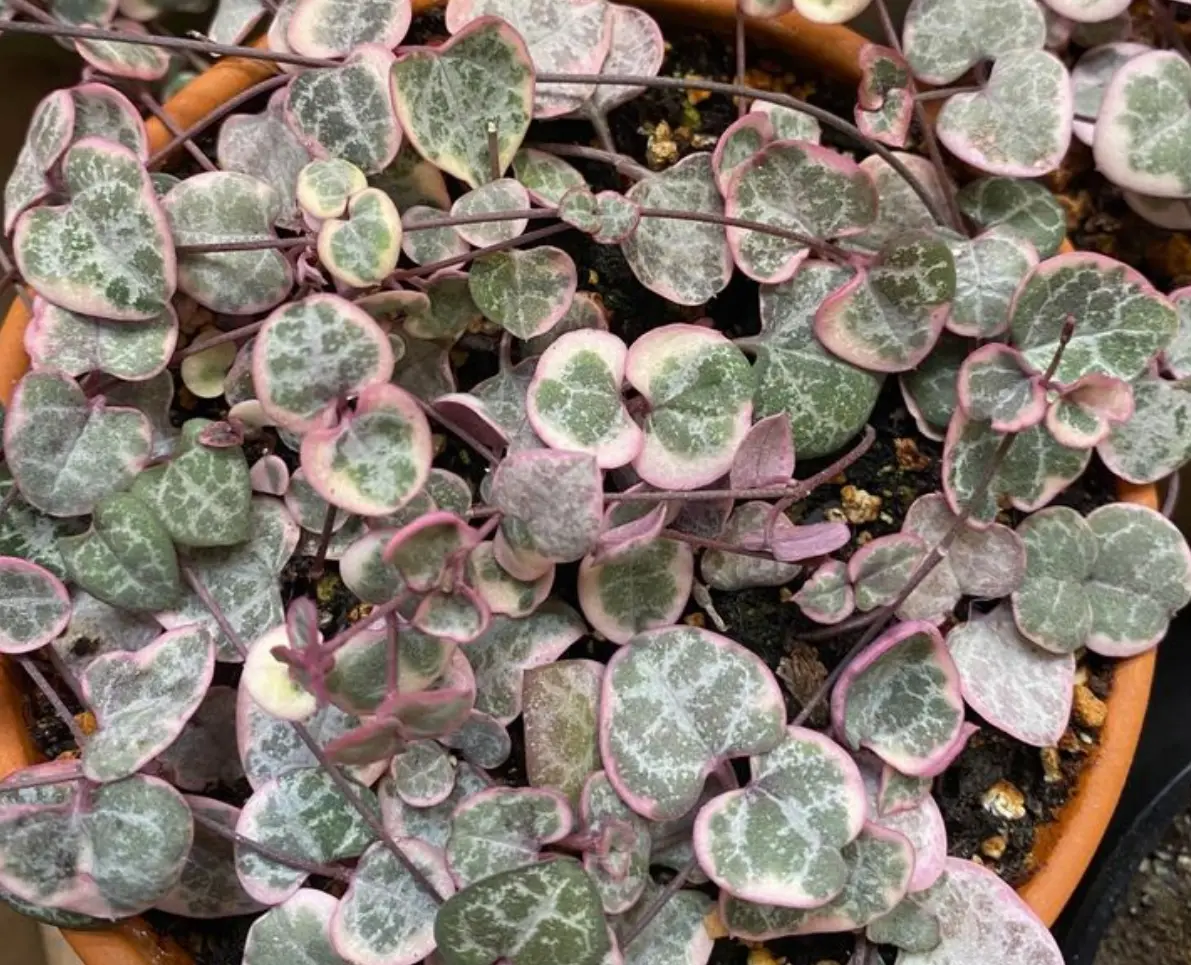
A variegated string of hearts (Ceropegia Woodii) is a hanging vine plant with heart-shaped, multicolored leaves that lives up to its name. This natural South African plant belongs to the Apocynaceae family and is known as the rosary vine, sweetheart vine, collar of hearts, and chain of hearts.
In the spring and summer, the stems of Variegated String of Hearts produce little pink tubers. Introduced in 1753, the Ceropegia Woodii is a beginner-friendly plant recommended for all gardeners.
Common Varieties of String of Hearts
A string of hearts comes in five varieties and is one of the cutest plants. Each one has something unique to give, and you can plant them in the same pot or grow them separately for a great, colorful combination.
The varieties of the string of hearts are as follows:
1. The Silver Glory
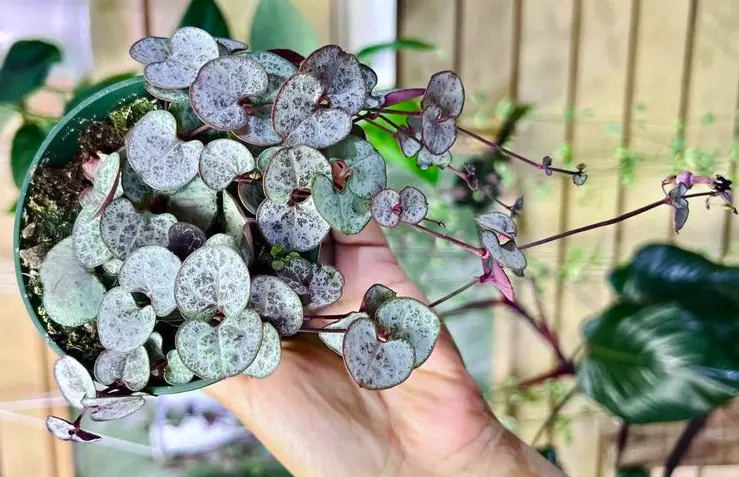
The silver glory is your best bet for a colorful Ceropegia Woodii variety to plant. If you’re searching for something different than the regular String of Hearts, then it is worthwhile to consider this houseplant. The bottom section and leaves of the silver glory are rounder, pointier, and less conspicuous.
2. The String of Spades
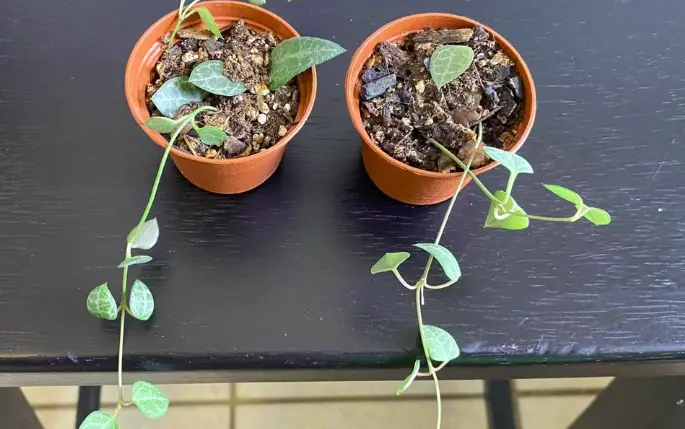
The string of spades is a lovely and unusual plant related to the more widespread Ceropegia Woodii. It has pointed leaves that look like spades or diamonds. Because of their fragile nature, they develop slower than other Ceropegias.
3. The Orange River
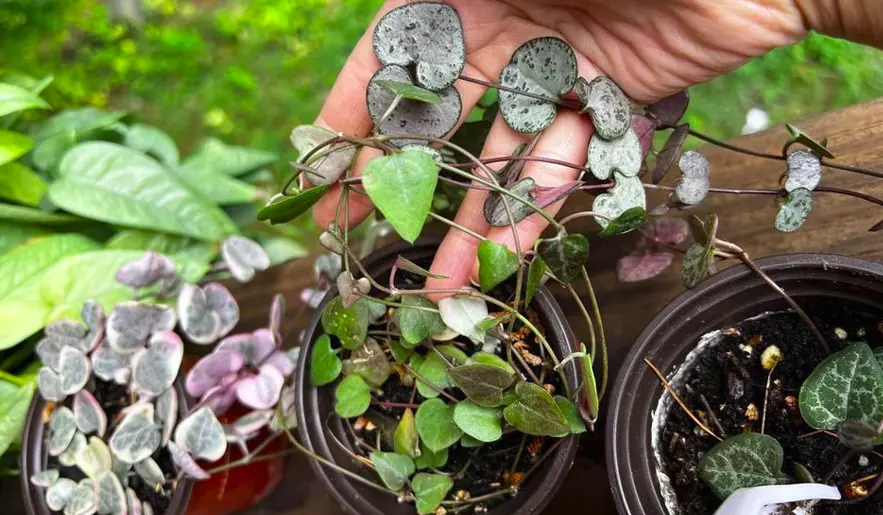
The Orange River is a more modest plant, with mostly green leaves rather than orange. Remarkably, when the plant is stressed, it’s under leaves, and leaves turn brown, revealing an attractive color that enhances its brightness.
4. The Mini Star

The mini star is a heart-shaped hanging plant that is ideal for terrariums. It forms opposing pairs of green lace motifs that can trail up to 10 feet. Although it is not a herbaceous perennial, it falls into the category since it stores water, and it only requires less maintenance and water because it is drought-resistant.
5. The Ceropegia Woodii or Regular String of Hearts
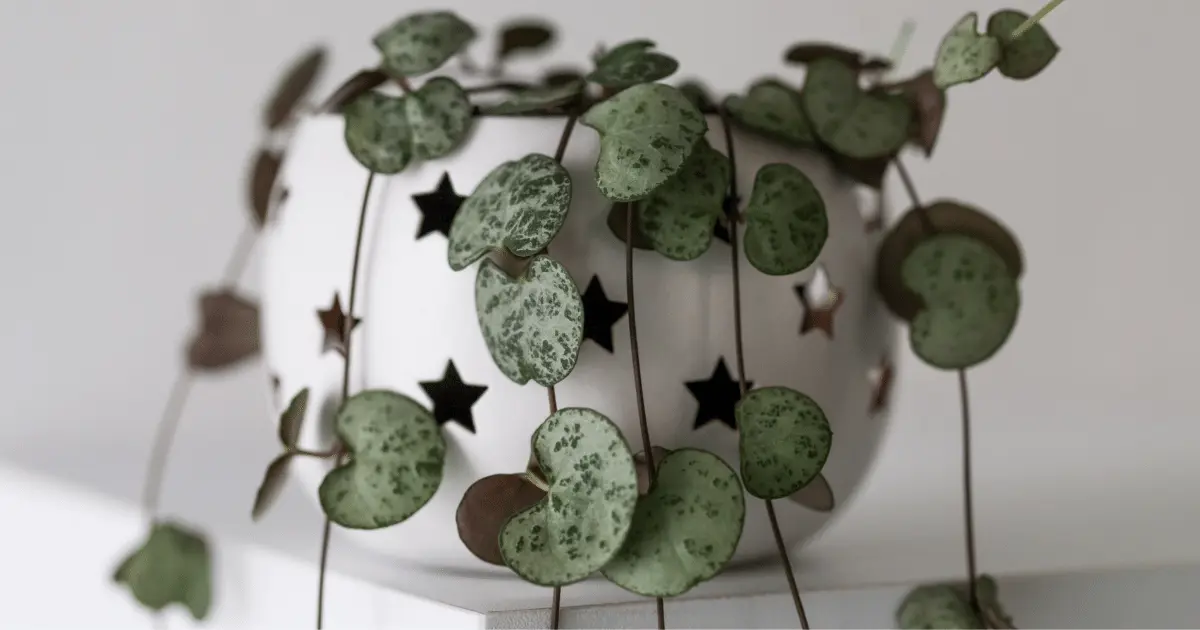
The Ceropegia Woodii is a lovely and delicate cultivar that takes little care to grow. In addition to being common, they are also easy to find. You can find this specie at local plant shops, online plant stores, and mountain gardens. They thrive indoors with very little exposure to high humidity and intense light.
Ways to Grow Variegated String of Hearts
The variegated strings of hearts can be grown both indoors and outdoors. You need to water them occasionally and give them adequate humidity and sunlight to grow, just like other exotic species. Whether you are growing them indoors or outdoors, these tips will be helpful.
Growing the Variegated String of Hearts Indoors
Like other succulent plants, the variegated String of Hearts dislikes direct sunshine because it scorches its leaves. On the other side, if you keep them in the shade for too long, they may get overwatered and discolored. Here are some recommendations to help them grow inside.
Step 1: Select a succulent pot and the appropriate potting mix.
These two elements are essential when cultivating a variegated string of hearts since they hate being overwatered. If you’re unsure about the potting mix, go with the cactus mix. This type of soil has a high water-draining capacity, which prevents the ground from retaining too much moisture.
The pot should also be very well-draining to prevent the plant roots from absorbing too much water. When you fail to drain the water from the pot, the accumulated moisture might lead to fungal contamination of the roots.
Step 2: Select an excellent indoor spot for your plant.
Your variegated string of hearts needs a proper amount of sunlight exposure. It would be best to put them in strategic spots indoors, such as underneath the skylights, near the windows, or wherever they can get sunlight exposure. They require at least 3-4 hours of indirect morning sunlight, and you can move them to a spot with partial shade in the afternoon.
Step 3: Provide the plant with its basic requirements.
You need to water the plant moderately because it is drought-resistant. Before adding water:
- Make sure the soil is 90% dry.
- Maintain a temperature of 60 degrees Fahrenheit or less.
- Remember to repot them when they outgrow their old pot or vessels.
Growing the Variegated String of Hearts Outdoors
The best way to see your variegated String of Hearts blossom quickly is to plant them outdoors. You may let them crawl in your garden or tumble down your walls in the summer. When growing the string of hearts outdoors, you should consider these two vital steps:
Step 1: Find a perfect outdoor setting
Remember that these plants thrive in USDA zones ten and higher or in regions with temperatures of 60 ° C. or higher. If you’re not sure if the location you’ve chosen meets the zoning, temperature, and humidity criteria, you can better still plant your string of hearts in a vase. This allows you to move them around to areas with better conditions swiftly.
Step 2: Be sure to bring your plant indoors when the temperature lowers
Assuming the temperature outside falls below 60 ℃, you shouldn’t forget to bring your potted variegated string of hearts inside. Leaving them outdoors at this time could be fatal since they might not withstand the freezing temperatures. As a precaution, always ensure to bring them in if the temperature falls.
Ways of Caring for Variegated Strings of Hearts
Neglected houseplants, such as the variegated String of Hearts, are so aptly named for a reason. You don’t have to continue caring for them or ensuring they have the greatest possible living circumstances. These are the fundamentals to remember when caring for these one-of-a-kind plants:
1. Fertilizing
Because the String of Hearts plant is a fragile vine, excessive fertilization isn’t recommended. As a result, you only need to apply standard diluted home fertilizer once a month throughout the growing season, which lasts from March to August. They are dormant over the winter, so you do not need to fertilize them.
2. Watering
The variegated String of Hearts plant is a plant that can flourish in the absence of water. Water is required to moisten the soil, which should then be allowed to dry before watering it again. When you realize that the soil is already 90% dry, it’s time to water. Watering frequency is determined by the weather and growing zone.
During the summer, you only have to water them either once-twice a week. Water the plant once every 11 to 15 days throughout the winter when it is dormant. Overwatering your string of hearts will cause the plant to wilt.
3. Maintenance and Pruning
Regular maintenance and pruning can help your string of hearts develop more fully. Pruning is most effective during the active growth season when the plant can recover fast. Another time to prune is when you notice older or dying plants. If you see any leggy growth, this is typically an indication that your plant isn’t getting enough light.
As a result, remove the older leaves from the parent plant when you notice them wilting to maintain your plant and keep it healthy. We recommend that you prune this growth after addressing the problem underlying it.
4. Temperature
The ideal temperature range for plant development is 66 to 90 degrees Celsius. Maintain a temperature of 40 degrees Fahrenheit or higher at night. Because the string of hearts is sensitive to cold and frost, you must move it to a warmer spot when the temperature falls.
5. Humidity
Fortunately, the variegated String of Hearts plant is not fussy about humidity. They can live and grow in the typical humidity level of your location and keep them away from windows, doors, and the air conditioner.
The variegated string of hearts thrives in a stable home environment. Avoid putting your string of hearts near windows or an outdoor entrance to prevent extreme temperature swings.
6. Sunlight
The variegated string of hearts prefers indirect yet intense sunshine. In this scenario, place them on a windowsill or in a well-lit area to keep them happy. If you’re growing them indoors, set them a few feet away from a South-facing window that gets the most direct sunshine per day.
Another viable option is to place the plant near an East-facing window or a West-facing window that catches morning or afternoon sunlight for half of the day. Growing a variegated string of hearing near a North-facing window would likely produce thin and lean growth, so a grow light is recommended.
7. Soil Mix
Use any well-draining potting mix for your variegated String of Hearts to thrive. If you doubt, using a cacti mix is a safe bet. Using standard houseplant soil, consider adding grit, sand, pumice, or perlite to help with water drainage. Most cactus mixtures contain one or more of these components.
To improve drainage even more, ensure to put the string of hearts in a container with drainage holes and try growing it in a terracotta vase, which will naturally help wick away excess water. Consider planting them in a suspended basket or a standard container.
Planting in unsuitable soil that enables water to accumulate can result in waterlogged soils and damp feet, which can cause root rot and parasitic infestation in your variegated string of hearts.
